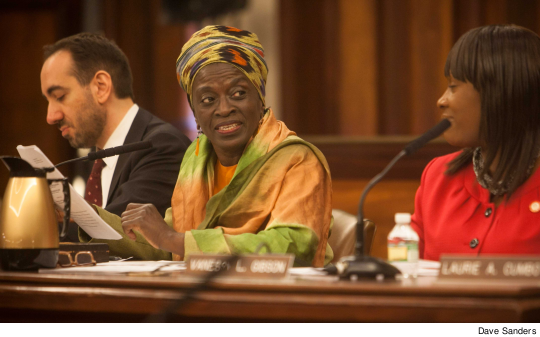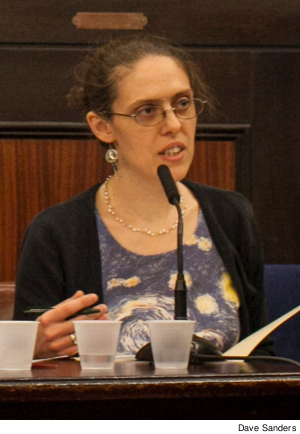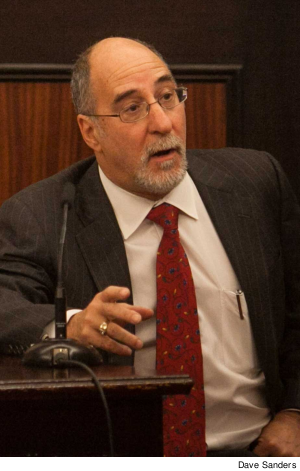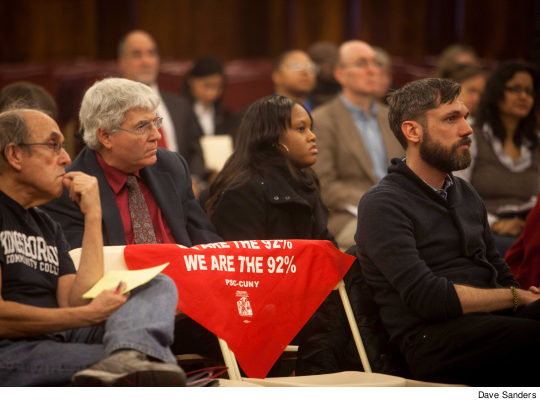 |
Speakers from more than a dozen campuses testified at the New York City Council Higher Education Committee’s first hearing on the CUNY administration’s Pathways curriculum. Below are excerpts from some of the testimony at the February 25 hearing, which included many specific accounts of how Pathways has begun to undermine CUNY students’ education.
For more Pathways coverage in this issue of Clarion, read about the details of the city council meeting, find out about the status of lawsuits and submit your own personal story on how Pathways is affecting the curriculum.
Michael Batson
Adjunct Lecturer in History
College of Staten Island
I teach in a program at the College of Staten Island taken by all incoming freshmen, designed to introduce them to the major ideas, institutions and issues of the United States. The course plays an important part in socializing freshmen to the college experience, helping them move from merely summarizing to analyzing, working with them on building critical thinking skills, and teaching them how to create sustained and supported arguments…. Now that the course has been reduced from four credits to three, we are being asked to cover the same material in 45 hours instead of 60. That reduction in contact hours can only come at the expense of depth, breadth and rigor.
What is happening in this one particular course is taking place across the entire curriculum, from the humanities to the natural sciences, and across every campus at CUNY…. I would ask that this policy be revisited. Where the motivation is to help our students, we can find common ground. The administration, faculty and students working together can talk about the real issues affecting graduation rates, and work on solutions that don’t water down our students’ education.
 |
Saavik Ford
Associate Professor of Astronomy
Borough of Manhattan Community College
At BMCC, pre-Pathways, our liberal arts majors took two science courses, each with a rigorous lab, each for five hours per week. Now they take two science courses, only one with a lab, each meeting for only three hours per week. Our students deserve more than three-fifths of a science class….
Current national best practice is a four-credit laboratory class, meeting for at least five hours per week for non-science majors. We invite national ridicule – not to mention transfer problems – by shortening our courses at the expense of understanding. In our increasingly scientific and technical world, when people must be scientifically literate to participate in many of our political discussions, cutting time on science leaves our students disenfranchised as citizens of the future….
Given CUNY’s long, proud history as a leader in science, and the fact that this is the CUNY Decade of Science, I implore you to let the faculty fix the transfer situation – without diminishing the scientific rigor of a CUNY degree.
 |
Seth Lipner
Professor of Law
Baruch College
I am chair of the Undergraduate Curriculum Committee at [Baruch’s] Zicklin School [of Business], a position I have held for 21 years…. During my tenure on the curriculum committee, Baruch College developed and implemented what I consider to be the two most signal advancements in our curriculum: the advent of “communication intensive courses” stressing writing and speech (and the requirement that our students take a set number of such courses in order to graduate), and a requirement that our business majors take a minor in a liberal arts subject of their choosing. These minors all include a liberal arts “capstone” course that emphasizes both critical thinking and high-level oral and written communication….
Eighty percent of Baruch College students will graduate with degrees in business. Business students take more than half their college credits in business, professional and technical subjects. It is especially important that these business students, who will compete for jobs with students from the best private and public institutions, gain both the communication skills and the depth of general knowledge which these curricular innovations foster.
Unfortunately, the Pathways general education rules allow many transfer students to pursue a less rigorous, lowest-common-denominator curriculum that permits them to avoid fulfilling these two degree requirements…. By permitting such students to avoid these and other previously existing degree requirements, the Pathways general education rules threaten to harm our educational efforts and damage our college’s reputation for excellence….
It is not too late for CUNY to reconsider and amend the Pathways general education program.
Nivedita Majumdar
Associate Professor of English
John Jay College
Will Pathways improve graduation rates? The primary reason for low graduation rates in CUNY has to do with the demographics of our student body. Our largely immigrant and working-class students have to negotiate work schedules and family responsibilities while attending college. Based on conversations with my students over the years, I know that the decision to drop out is always an extremely difficult one. Their decision has little to do with curriculum; it is almost always a question of time and financial resources. How will a program like Pathways that streamlines curriculum help with this core problem?…
[Pathways’] reduction in the general education curriculum ensures that our students are denied a well-rounded liberal arts education. It means students could graduate with a bachelor’s degree without ever having taken a literature or a history course, or without any training in a foreign language, or with reduced time in science labs. Our students are thus denied the intrinsic value of a good education. We also know that for higher levels of the job market, both in the public and private sectors, employers seek candidates with well-honed analytical skills, something acquired through a well-rounded and not a vocationalized education. Pathways ensures that our students will be equipped to fill only a certain stratum of the job market….
Pathways works against CUNY’s admirable mission of providing quality education to the underprivileged population of the city. As educators we know that our students are capable and deserving of the best. We do need to engage with the question of graduation rates, but let us not try to do that at the expense of providing the best possible education to our students.
Jonathan Natov
Professor of Mathematics
New York City College of Technology
I am the coordinator of [City Tech’s] bachelor of science degree program in applied mathematics.
The applied mathematics program at City Tech was designed to be practical. With extensive input from our industry advisory board, we put together a professionally oriented program. A key feature was the areas of concentration, which allowed students to study mathematical applications in depth. In 2007, our external evaluator praised our program as being an “exemplar” of the mission of City Tech.
Under Pathways, however, we face the challenge of having diluted degree requirements. Essentially the problem is that bachelor of science degrees can no longer specify courses in the common core. The result is that specified upper-level courses are replaced by lower-level unspecified courses….
For example, to progress to upper-level engineering courses, students need to take physics. Under Pathways, we must accept any science. To ensure students take physics, and keep our degree requirements to a strict 120-credit limit, we must now make room for physics by cutting other courses. Unfortunately, the cut courses have to be upper-level. Clearly, we cannot cut the lower-level engineering courses, as they are prerequisites for upper-level courses.
Our hope is that students interested in applied mathematics make good choices so as to allow them access to upper-level coursework, but we cannot guarantee it. Before Pathways, calculus was the minimal contributory math course and that is appropriate for applied mathematics. Under Pathways, the first contributory course is likely to be a lower-level college algebra course.
Surely the intention was not to lower the standards of a bachelor of science degree, but that is the result.
 |
Manfred Philipp
Professor of Chemistry
Former Chair, University Faculty Senate
Lehman College
CUNY’s trustees voted for Pathways over the opposition of college senates across the system. My college senate, representing faculty, students and administration, has voted twice to oppose the implementation of Pathways. My opposition to Pathways is informed by my 36-plus years of experience in CUNY.
[To cite one] of the many reasons why my colleagues and I oppose Pathways….Pathways will act to reduce graduation rates by releasing community college students from the need to complete the community college associate’s degree. Pathways does this by allowing students to transfer all of their course credits to the senior colleges before graduation.
Prior to CUNY’s Pathways, Lehman College would readily accept community college core curriculum credits whenever the student completed the community college curriculum with an associate’s degree. Pathways, by severing credit transfer from community college graduation, confronts those transfer students with a senior college curriculum that they often are not ready to handle. The unique ability of community college faculty to prepare their students for the more rigorous senior college curricula is wasted. Not only that – having students leave before graduation harms community colleges by reducing their graduation rates….
By allowing premature transfer with full transfer of credit, Pathways fosters a population of students that leaves CUNY with no degree at all, [without] the associate’s degree that they could have received had they not transferred early….
Pathways is a disgrace. The vast majority of my full-time colleagues in all parts of CUNY have voted no confidence in Pathways. We ask…to abolish Pathways and return the CUNY curriculum to the status prior to Pathways implementation.
Kate Schowe
College Laboratory Technician
John Jay College
I am a College Laboratory Technician [CLT] for environmental and natural science courses. Four of the five lab courses I am responsible for are Pathways labs. I am the CLT for 13 sections of Pathways labs every week, allowing me to directly observe the impact [that] limiting lab contact hours to one hour per week is having on our students and faculty.
After all students arrive and instructors give a brief overview of the purpose of the lab and methods, the students are left with, at the very most, 30 minutes to complete the lab exercise and 10 minutes to complete the lab report. I often hear students complain that there is not enough time. From my experience, I would estimate one-third of the students are able to comfortably complete the lab in 40 minutes…. The remainder often feel…rushed and/or confused…. The instructors and students [often have] no time to discuss the results at the end of a lab, or…to provide detailed, thoughtful answers to lab report questions.
I recently was the CLT for a lab section in which the instructor began lab with a brief presentation and discussion in order to ensure that students understood the purpose of the lab and relevant background information. In a traditional lab course, a similar discussion would have taken place in [a separate class session]. However, because this was a Pathways lab, this brief overview resulted in 90% of the students not being able to complete the lab. The instructor had to tell the students to stop before they collected any data because they had run out of time….Additional [class] time would make a huge difference in the student’s overall lab experience.
Susan Jacobowitz
Associate Professor of English
Queensborough Community College
My introduction to Pathways was particularly traumatic; as a member of the English Department at Queensborough Community College, we were directed to change our three-credit, four-hour composition classes to three-credit, three-hour classes to make them fit into Pathways. Voting our collective conscience, thinking about the needs of our students and their goals, we voted to maintain our classes at four hours. What followed is part of the public record: the threat to fire all full-time and adjunct faculty, the warning that the English department at Queensborough would be closed and students would have to fulfill their English requirements elsewhere.
Pathways has run roughshod over faculty and made a mockery of shared governance. But ultimately, this is not about faculty; it is about students. Pathways threatens to gut the CUNY undergraduate degree in order to enhance graduation rates. This proud institution, which has served so many so well for so many years, is in danger of becoming the symbol of the “pretty good” or “good enough” education….
Our students have the same potential as other college students. If rigor is taken out of their degree in the form of foreign languages or lab requirements – if working in a recognized academic discipline is replaced with satisfying requirements for various “buckets” – it is the students who suffer….
We must keep opportunity alive for CUNY students.

